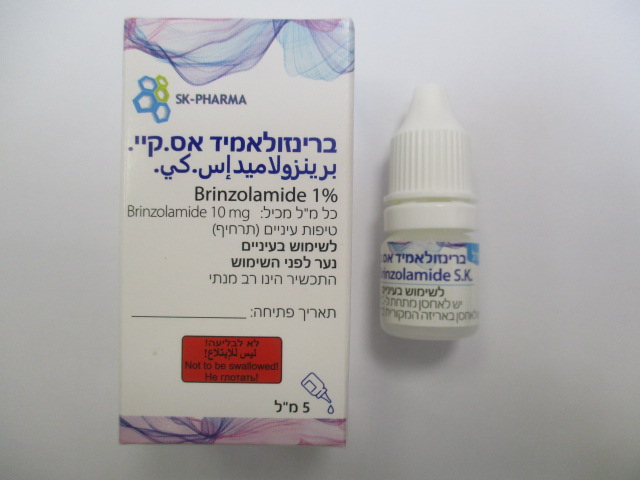Quest for the right Drug

ברינזולאמיד אס.קיי. BRINZOLAMIDE SK (BRINZOLAMIDE)
תרופה במרשם
תרופה בסל
נרקוטיקה
ציטוטוקסיקה
צורת מתן:
עיני : OCULAR
צורת מינון:
תרחיף לעין : EYE DROPS, SUSPENSION
עלון לרופא
מינוניםPosology התוויות
Indications תופעות לוואי
Adverse reactions התוויות נגד
Contraindications אינטראקציות
Interactions מינון יתר
Overdose הריון/הנקה
Pregnancy & Lactation אוכלוסיות מיוחדות
Special populations תכונות פרמקולוגיות
Pharmacological properties מידע רוקחי
Pharmaceutical particulars אזהרת שימוש
Special Warning עלון לרופא
Physicians Leaflet
Adverse reactions : תופעות לוואי
4.8 Undesirable effects Summary of the safety profile In clinical studies involving 2732 patients treated with brinzolamide as monotherapy or adjunctive therapy to timolol maleate 5 mg/ml, the most frequently reported treatment-related adverse reactions were: dysgeusia (6.0%) (bitter or unusual taste, see description below) and temporary blurred vision (5.4%) upon instillation, lasting from a few seconds to a few minutes (see also section 4.7). Tabulated summary of adverse reactions The following adverse reactions have been reported with brinzolamide 10mg/ml eye drops, suspension and are classified according to the following convention: very common (≥1/10), common (≥1/100 to <1/10), uncommon (≥1/1,000 to <1/100), rare (≥1/10,000 to <1/1000), very rare (<1/10,000), or not known (cannot be estimated from the available data). Within each frequency grouping, adverse reactions are presented in order of decreasing seriousness. The adverse reactions were obtained from clinical trials and post-marketing spontaneous reports. System Organ Classification MedDRA Preferred Term (v.15.1) Infections and infestations Uncommon: nasopharyngitis, pharyngitis, sinusitis Not Known: rhinitis Blood and lymphatic system disorders Uncommon: red blood cell count decreased, blood chloride increased Immune system disorders Not Known: hypersensitivity Metabolism and nutrition disorders Not known: decreased appetite Psychiatric disorders Uncommon: apathy, depression, depressed mood, libido decreased, nightmare, nervousness Rare: insomnia Nervous system disorders Uncommon: motor dysfunction, amnesia, dizziness, paraesthesia, headache Rare: memory impairment, somnolence Not Known: tremor, hypoaesthesia, ageusia Eye disorders Common: blurred vision, eye irritation, eye pain, foreign body sensation in eyes, ocular hyperaemia Uncommon: corneal erosion, keratitis, punctate keratitis, keratopathy, deposit eye, corneal staining, corneal epithelium defect, corneal epithelium disorder, blepharitis, eye pruritus, conjunctivitis, eye swelling, meibomianitis, glare, photophobiadry eye, allergic conjunctivitis, pterygium, scleral pigmentation, asthenopia, ocular discomfort, abnormal sensation in eye, keratoconjunctivitis sicca, subconjunctival cyst, conjunctival hyperaemia, eyelids pruritus, eye discharge, eyelid margin crusting, lacrimation increased Rare: corneal oedema, diplopia, visual acuity reduced, photopsia, hypoaesthesia eye, periorbital oedema, intraocular pressure increased, optic nerve cup/disc ratio increased Not Known: corneal disorder, visual disturbance, eye allergy, madarosis, eyelid disorder, erythema of eyelid Ear and labyrinth disorders Rare: tinnitus Not Known: vertigo Cardiac disorders Uncommon: cardio-respiratory distress, bradycardia, palpitations Rare: angina pectoris, heart rate irregular Not Known: arrhythmia, tachycardia, hypertension, blood pressure increased, blood pressure decreased, heart rate increased Respiratory, thoracic and mediastinal Uncommon: dyspnoea, epistaxis, oropharyngeal pain, pharyngolaryngeal disorders pain, throat irritation, upper airway cough syndrome, rhinorrhoea, sneezing Rare: bronchial hyperreactivity, upper respiratory tract congestion, sinus congestion, nasal congestion, cough, nasal dryness Not Known: asthma Gastrointestinal disorders Common: dysgeusia Uncommon: oesophagitis, diarrhoea, nausea, vomiting, dyspepsia, upper abdominal pain, abdominal discomfort, stomach discomfort, flatulence, frequent bowel movements, gastrointestinal disorder, hypoaesthesia oral, paraesthesia oral, dry mouth Hepato-biliary disorders Not Known: liver function test abnormal Skin and subcutaneous tissue disorders Uncommon: rash, rash maculo-papular, skin tightness Rare: urticaria, alopecia, pruritus generalised Not Known: Stevens-Johnson syndrome (SJS)/toxic epidermal necrolysis (TEN) (see section 4.4), dermatitis, erythema Musculoskeletal and connective tissue Uncommon: back pain, muscle spasms, myalgia disorders Not Known: arthralgia, pain in extremity Renal and urinary disorders Uncommon: renal pain Not Known: pollakiuria Reproductive system and breast disorders Uncommon: erectile dysfunction General disorders and administration site Uncommon: pain, chest discomfort, fatigue, feeling abnormal conditions Rare: chest pain, feeling jittery, asthenia, irritability Not Known: peripheral oedema, malaise Injury, poisoning and procedural Uncommon: foreign body in eye complications Description of selected adverse events Dysgeusia (bitter or unusual taste in the mouth following instillation) was the most frequently reported systemic adverse reaction associated with the use of brinzolamide during clinical studies. It is likely caused by passage of the eye drops in the nasopharynx via the nasolacrimal canal. Nasolacrimal occlusion or gently closing the eyelid after instillation may help reduce the incidence of this effect (see also section 4.2). brinzolamide is a sulphonamide inhibitor of carbonic anhydrase with systemic absorption. Gastrointestinal, nervous system, haematological, renal and metabolic effects are generally associated with systemic carbonic anhydrase inhibitors. The same type of adverse reactions that are attributable to oral carbonic anhydrase inhibitors may occur with topical administration. No unexpected adverse reactions have been observed with brinzolamide when used as adjunctive therapy to travoprost. The adverse reactions seen with the adjunctive therapy have been observed with each active substance alone. Paediatric population In small short-term clinical trials, approximately 12.5% of paediatric patients were observed to experience adverse reactions, the majority of which were local, non-serious ocular reactions such as conjunctival hyperaemia, eye irritation, eye discharge, and lacrimation increased (see also section 5.1). Reporting of suspected adverse reactions Reporting suspected adverse reactions after authorization of the medicinal product is important. It allows continued monitoring of the benefit/risk balance of the medicinal product. Any suspected adverse events should be reported to the Ministry of Health according to the National Regulation by using an online form http://sideeffects.health.gov.il

שימוש לפי פנקס קופ''ח כללית 1994
לא צוין
תאריך הכללה מקורי בסל
לא צוין
הגבלות
לא צוין
רישום
163 25 35121 00
מחיר
0 ₪
מידע נוסף
